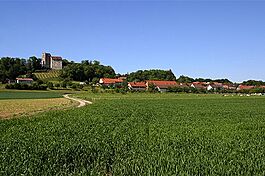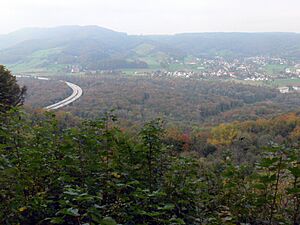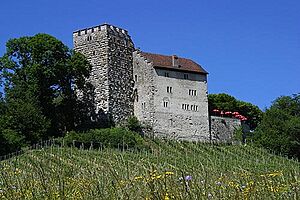Habsburg, Switzerland facts for kids
Quick facts for kids
Habsburg
|
||
|---|---|---|

Habsburg village
|
||
|
||
| Country | Switzerland | |
| Canton | Aargau | |
| District | Brugg | |
| Area | ||
| • Total | 2.23 km2 (0.86 sq mi) | |
| Elevation | 470 m (1,540 ft) | |
| Population
(Dec 2020 )
|
||
| • Total | 428 | |
| • Density | 191.9/km2 (497.1/sq mi) | |
| Postal code |
5245
|
|
| Surrounded by | Brugg, Hausen, Scherz, Schinznach-Bad | |
Habsburg is a small town, also called a municipality, in Switzerland. It's located in the canton of Aargau, about three kilometers southwest of the town of Brugg. Habsburg is famous because it's named after Habsburg Castle. This castle was built around 1020–1030. It was built for Count Radbot, who was from a nearby area called Klettgau.
Contents
History of Habsburg
Even though people lived here in the Bronze Age and Roman times, the village of Habsburg was first mentioned in 1027. Back then, it was called Habesbur or Habeburch.
The village was first written about around the same time Count Radbot built Habsburg Castle. People believe the castle was named after a hawk (which is Habicht in German) that was seen sitting on its walls. Some historians think the name might come from an old German word 'hab' or 'hap', meaning a place to cross a river. This is because the castle is near a place where you could cross the Aar River. Habsburg Castle became the original home of the House of Habsburg. This family later became one of the most powerful royal families in Europe.
The House of Habsburg owned the castle until 1415. That's when Duke Frederick IV lost the Aargau region to the Swiss Confederacy.
The area around Habsburg Castle was mostly covered by forests. These forests were cleared for farming and building around 1500. This was almost 500 years after the castle was first built!
Habsburg was always part of the church area of Windisch. The village grew slowly. In 1529, there were only four houses. The first school was built much later, in 1747. For a long time, people mostly worked in farming, including growing some grapes. Around 1800, a small plaster industry started. More buildings were added over time, like a new schoolhouse in 1818 and a fire station in 1896. The village got its own water supply in 1908 and electricity in 1916.
By 1960, fewer people lived in Habsburg because there weren't many jobs. But the population grew again after 1971 when new houses were built. Since 1984, a bus service called Postauto has connected Habsburg to other places.
Geography of Habsburg
Habsburg covers an area of about 2.23 square kilometers (0.86 square miles). A big part of this land, about 30%, is used for farming. Even more, about 61%, is covered by forests. The remaining 9% is where buildings and roads are located.
Most of the built-up area, about 5.8%, is for houses and other buildings. Roads and other transport areas make up 2.7%. The forests cover a large part of the land, about 61%. For farming, 25.6% of the land is used for growing crops, and 3.6% is for pastures where animals graze.
The municipality is in the Brugg district. It includes the village of Habsburg, which is a haufendorf. This means it's an unplanned village with houses built close together around a central area. The village is located below Habsburg Castle, above the Aare river valley.
Habsburg's Coat of Arms
The coat of arms for Habsburg shows a picture of Habsburg Castle. It's described as a blue shield with a green hill. On the hill is a blue house with a red roof and a square black tower. This design represents the famous castle and the area's history.
People of Habsburg
Habsburg has a population of 428 people. A small part of the population, about 6.5%, are people from other countries. Most people in Habsburg, about 96.7%, speak German. Italian is the second most common language, and French is third.
Let's look at the age groups in Habsburg. About 8.2% of the people are children aged 0 to 9 years old. Teenagers, aged 10 to 19, make up about 12.6% of the population. Adults aged 20 to 29 are about 11.9%. People between 30 and 39 are 12.9%, and those between 40 and 49 are 21.1%. About 16.2% are between 50 and 59 years old. Older adults, aged 60 to 69, are 8.7%. Those between 70 and 79 are 6.8%. A very small number, about 1.2%, are between 80 and 89, and 0.5% are 90 or older.
Many homes in Habsburg are owned by the people who live in them, about 62.3%. In 2000, there were 9 homes with 1 or 2 people, 50 homes with 3 or 4 people, and 79 homes with 5 or more people. On average, there were 2.56 people living in each home. In 2008, 90 homes were single-family houses, which is about 52.6% of all homes and apartments.
Most people in Switzerland are well-educated. In Habsburg, about 88.1% of adults (aged 25–64) have finished high school or gone on to higher education like university. In the 2008/2009 school year, 20 students attended primary school in Habsburg.
Here's how the population of Habsburg has changed over time:
| Historical population | ||
|---|---|---|
| Year | Pop. | ±% |
| 1798 | 98 | — |
| 1850 | 176 | +79.6% |
| 1900 | 144 | −18.2% |
| 1950 | 133 | −7.6% |
| 1960 | 126 | −5.3% |
| 1975 | 227 | +80.2% |
| 1980 | 254 | +11.9% |
| 1990 | 327 | +28.7% |
| 2000 | 368 | +12.5% |
Important Heritage Sites
Habsburg Castle is a very important historical place in Switzerland. It is listed as a heritage site of national significance. This means it's a special place that is protected because of its history and importance to the country.
Habsburg's Economy
In 2007, the unemployment rate in Habsburg was low, at 1.44%. This means most people who wanted to work had jobs.
In 2005, 13 people worked in the primary economic sector. This sector includes jobs like farming and forestry. There were 3 businesses in this area. Nine people worked in the secondary sector. This includes jobs like manufacturing and construction. There were 3 businesses here. The largest number of people, 39, worked in the tertiary sector. This sector includes jobs in services, like shops, offices, and tourism. There were 9 businesses in this sector.
In 2000, 202 people who lived in Habsburg had jobs. Most of them, about 83.2%, worked outside of Habsburg. However, 25 people came into Habsburg for work. There were a total of 59 jobs in the municipality. About 12.1% of working people used public transportation to get to their jobs, and 56.5% used a private car.
Religion in Habsburg
Based on information from 2000, about 23.1% of the people in Habsburg were Roman Catholic. A larger group, about 59.8%, belonged to the Swiss Reformed Church. A very small number, about 0.54%, were part of the Christian Catholic faith.
See also
 In Spanish: Habsburg (Argovia) para niños
In Spanish: Habsburg (Argovia) para niños







